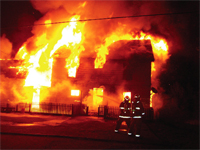
Features
Hot topics
Incident reports
Incident Report: Fire too advanced for interior attack
Volunteer firefighters with the Musquash Fire Department in New Brunswick responded to a report of a structure fire at 11 Little Lepreau Rd. on Sunday, May 27, 2007.
March 18, 2008
By Andrew Sanojca
 |
| Fire extended into the garage of the 96-year-old wooden structure within 15 minutes of firefighters arriving on scene. PHOTO COURTESY ANDREW SANOJCA |
Volunteer firefighters with the Musquash Fire Department in New
Brunswick responded to a report of a structure fire at 11 Little
Lepreau Rd. on Sunday, May 27, 2007.
The call was paged out at 2:03 a.m. A captain, while en route to
Station 2, was monitoring radio traffic, and, knowing that there were
enough firefighters responding to the station to get the trucks
rolling, went directly to the scene.
A firefighter who lives near the scene arrived at the station as Engine
2 was leaving at 2:13 a.m. and told the two firefighters on board the
back end that the house was fully involved.
The captain arrived on scene a couple minutes later and conducted a
scene survey. He radioed his on-scene report to responding firefighters
and indicated that the two-storey wooden house was heavily involved in
fire in the B-C corner, that all occupants were out and that conditions
would not allow an interior attack. Efforts were to be concentrated on
saving an attached garage. The house was a two-storey wood frame single
family home with attached garage. It was built in 1911.
On arrival at 2:18 a.m., Engine 2 was positioned on the road in front
of the house. A 1.75-inch pre-connect attack line with class-A foam was
advanced toward the house and an exterior attack was made to keep the
flames from the garage, using water from the on-board 1,200-gallon
tank. This line was manned by the two firefighters who arrived on
Engine 2, with the captain taking control of the pump panel. Fire was
visible on the bottom floor and the front door appeared to have been
left open. The flames had already blown out several windows.
On arrival of Engine 3 and Rescue 3 with four more firefighters, the
portable tank from Engine 2 was placed behind the pumper and Engine 3
dumped its load of water. Firefighters were unable to slow the fire,
which had taken hold of the 96-year-old building. A second 1.75-inch
pre-connect was advanced to the back side of the house. In order to
reach the seat of the fire at the back of the house, firefighters would
have had to operate in the collapse zone, so this line was repositioned
to the front of the now fully involved structure.
En route to the call, a request was made to dispatch for mutual aid
from the nearby Pennfield Fire Department. This fire occurred in a
rural area and water was shuttled to the scene by a tanker from
Pennfield and by Musquash Engines 1 and 3, both capable of carrying
1,350 gallons. The RCMP and local ambulance service were also on scene.
The three trucks shuttled water from the Point Lepreau Generating
Station, located about six kilometres away, which is equipped with a
hydrant system. The fire chief assumed command when he arrived on scene
and defensive operations continued. Staging, rehab and accountability
were set up at Rescue 1, which was also parked on the roadway.
| ON SCENE MUSQUASH FIRE DEPARTMENT
|
Within 10 minutes of the first truck arriving on scene, the fire
totally consumed the house, with the roof beginning to cave in. The
garage was also heavily involved and all efforts to stop the flames
were in vain. Fortunately, the only exposures to the original fire
building were trees and a hydro pole. Firefighters continued to wet
down the remains for several hours.
The cause of the fire remains undetermined. Two adult occupants were
able to flee the house but two of their three dogs perished. There were
no injuries to the occupants or fire-fighters.
Although the house was a total loss, ongoing training within the
department ensured this incident ran smoothly and safely. The
incident-command system is used on all calls, so it is second nature
when required at major incidents. Firefighters responding had the
benefit of an on-scene report from an experienced firefighter equipped
with a portable radio. Responding firefighters were aware all occupants
were out of the house, a good thing to know given the time of the call,
and that this was going to be a defensive operation. Mutual aid was
requested early, and dispatch had already requested the ambulance to
stand by.
Firefighters in this department face many residential challenges, from
old and new mini-homes, new bungalows to older two-storey wooden homes
dating 100 years or older, which have often been renovated or had
additions built on. Pre-planning and touring the response area helps
firefighters to prepare for emergencies.
Print this page
Advertisement
- Cracking down: Software helps communities locate grow ops and reduces threat to public safety
- Flammable gas: Propane leak, vapour cloud force evacuation in B.C. community